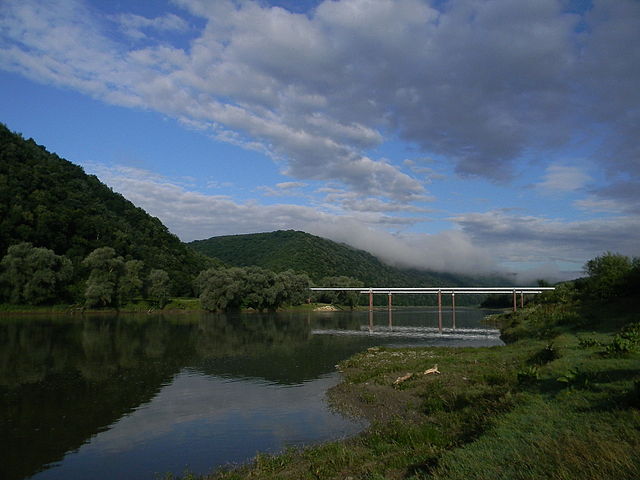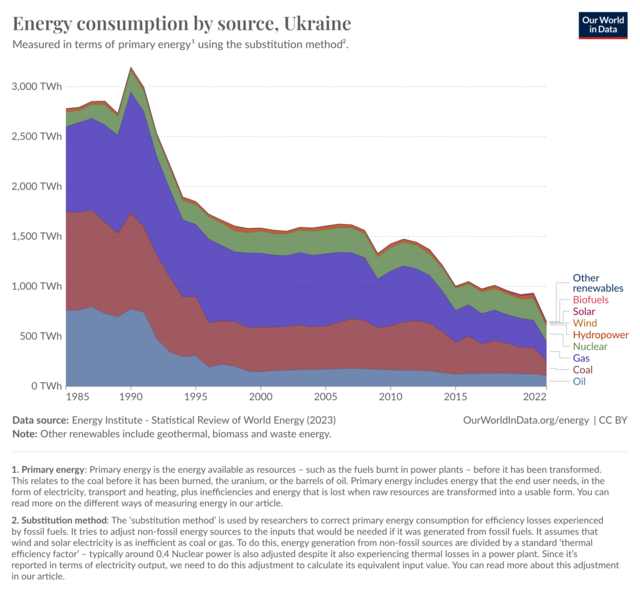Top Qs
Timeline
Chat
Perspective
Energy in Ukraine
From Wikipedia, the free encyclopedia
Remove ads
Energy in Ukraine primarily comes from gas and nuclear power, followed by oil and coal.[1] Ukraine has a diversified energy mix, and no fuel takes up more than a third of the country’s energy sources. Most gas and oil is imported, but since 2015 energy policy has prioritised diversifying energy supply.[1]

The coal industry has been disrupted by war,[2] and as of 2024 over 70% of electricity generation is nuclear.[3] The largest nuclear power plant in Europe, the Zaporizhzhia Nuclear Power Plant, is located in Ukraine. Fossil fuel subsidies were USD 1.6 billion in 2021.[4] Until the 2010s all of Ukraine's nuclear fuel came from Russia, but now most does not.[5]
Ukraine’s gas network has much storage, which can be useful for storing Europe's gas to even out supply and demand,[6] and in the first quarter of the 21st century it transited much Russian natural gas to Europe.[7] Some energy infrastructure was destroyed in the Russo-Ukrainian War,[8][9] but wind farms and solar power are thought to be resilient because they are distributed.[10] An energy strategy to 2050 was adopted in 2023 but has not yet been published.[11] There is a draft energy and climate plan to 2030.[12]

Remove ads
History
In 2011, Ukraine joined the European Energy Community, however there has been slow progress on implementing European energy regulations.[13]
Gas
Summarize
Perspective

Ukraine extracts about 20 billion cubic meters of fossil gas each year, and since 2022 this has almost met demand.[14] Ukraine has been estimated to possess natural gas reserves of over 670 billion cubic meters (in 2022),[15] and gas is an important part of energy in Ukraine. In 2021, Ukraine produced 19.8 billion cubic meters (bcm or Gm3) of natural gas. To satisfy domestic demand of 27.3 bcm that year, Ukraine relied on gas imports (2.6 bcm) and withdrawal from underground storage (4.9 bcm). Winter demand can reach 150 mcm per day.[16]
During Soviet times, Ukraine produced a record of 68.7 bcm in 1976. At the time of independence in 1991, production was at 26.6 bcm, and fell in the 1990s to about 18 bcm. Since the mid-2000s, production has stabilised between 20 and 21 bcm.[17] Over 70% of domestic gas production is extracted by UkrGasVydobuvannya,[18] a subsidiary of the state-owned company Naftogaz. Private gas production companies in Ukraine are DTEK, Ukrnaftoburinnya, Burisma, Smart Energy, Poltava Petroleum Company, Geo Alliance Group, and KUB-GAS.[19]
Ukraine stopped buying gas directly from Russia in 2015, to reduce gas dependence after the outbreak of the Russo-Ukrainian war.[20][16] The contract to transit Russian gas expired at the end of 2024.[21]Remove ads
Oil
In 2022 almost a fifth of total energy supply in Ukraine was from oil, and most energy imports were oil products such as gasoline and diesel.[22] The country used to produce and refine its own oil.[23] Strategic reserves of oil and products were set up after 2023 to help with energy security.[24]
Products from Lukoil have been banned from transiting the country,[25] except to Hungary.[26] This goes through the Druzhba pipeline.[27] Excise duty on diesel and gasoline was increased in 2024.[28] The Odesa–Brody pipeline is not being used as of 2023.[29] Refineries, such as Kremenchuk were destroyed or shutdown in 2022 in the Russo-Ukrainian war.[30]
Formerly supplied from Russia and Belarus, gasoline and diesel now come from ports in Poland and Romania.[31]Coal

Coal mining has historically been an important industry in Ukraine. Although the industry is often associated with the coal-rich Donets basin in the east of the country, other coal mining regions include the Lviv-Volhynian basin and the Dnieper brown coal mining basin. The Donets basin is Ukraine's most developed and largest coal mining region.
In 2013, Ukraine was the third largest coal producer in Europe. In 1976, national production was 218 million metric tonnes. By 2016, production had dropped to 41 million metric tonnes. The Donets Black Coal Basin in eastern Ukraine, with 90% of the nation's reserves, suffers from three connected problems: (1) mines are not profitable enough to sustain capital investment, resulting in aging mining equipment and processes, (2) the government, taking advice from the International Monetary Fund, has discontinued $600 million annual mining subsidies, and (3) the Ukrainian government refuses to buy from mines controlled by Russia.Remove ads
Electricity
Summarize
Perspective


Electricity is an important part of energy in Ukraine. Most electricity generation is nuclear,[32] and the system is inflexible.[33] The bulk of Energoatom output is sold to the government's "guaranteed buyer" to keep prices more stable for domestic customers.[34][35] Until the 2010s all of Ukraine's nuclear fuel came from Russia, but now most does not.[36]
Some electricity infrastructure was destroyed in the Russo-Ukrainian War,[37][38] but wind farms, solar power and batteries are thought to be resilient because they are distributed.[39] As of 2024 about 2 GW can be imported from other European countries, but that is not enough to cover peak demand.[32][40] Better air defence is needed,[41]: 5 and many small gas-turbine generators are being installed to generate flexibly to reduce the blackouts being caused by Russian attacks.[40]Renewable energy

Remove ads
Heating
District heating has been attacked and significantly damaged.[47] In 2024 the International Energy Agency (IEA) wrote about heat supply to Ukraine’s major cities. “Most attacks on heating infrastructure have occurred in regions close to the front lines. The Kharkiv region is now without large-scale heat generating capacity and other frontline regions – particularly Chernihiv, Donetsk, Zaporizhzhia, Sumy and Mykolaiv – have suffered severe damage to their heat generation capacities. Heat supply is also at risk in Ukraine’s capital, Kyiv.”[48]
Remove ads
Efficiency and demand response
In 2024 the IEA recommended engaging consumers in energy saving and demand response, while continuing investments in energy efficiency. They said that “a social tariff that safeguards a certain volume of consumption at subsidised rates, after which consumers pay a higher price, would help to incentivise efficient practices and investments, supported by public information campaigns that advise on energy efficiency measures for immediate impact as well as longer-term gains. Lowering the default temperature for district heating can also provide quick savings.”[48]
Remove ads
Personnel and finance
Ukraine signed a loan agreement in-principle for $3.65 billion with the China Development Bank in 2012, during President Viktor Yanukovich's term of office, contingent on the development of agreed projects in the coal and gas sectors. However, by 2017 Ukraine had not agreed any suitable projects due to a "lack of convergence in the positions of [Uglesintezgaz] and the energy ministry".[49] Elementum Energy Ltd owns the most power plants.[50][need quotation to verify]
The European Investment Bank is financing municipal district heating and energy efficiency projects.[51] Although by 2024 more women were working in the energy sector than before they were still underrepresented in leadership positions.[52]
Remove ads
During war

In the winter of 2022–23 Russia targeted switchyards and transformers, but the following year they concentrated on power plants perhaps because they are harder to protect and take longer to repair.[10]
References
Wikiwand - on
Seamless Wikipedia browsing. On steroids.
Remove ads
